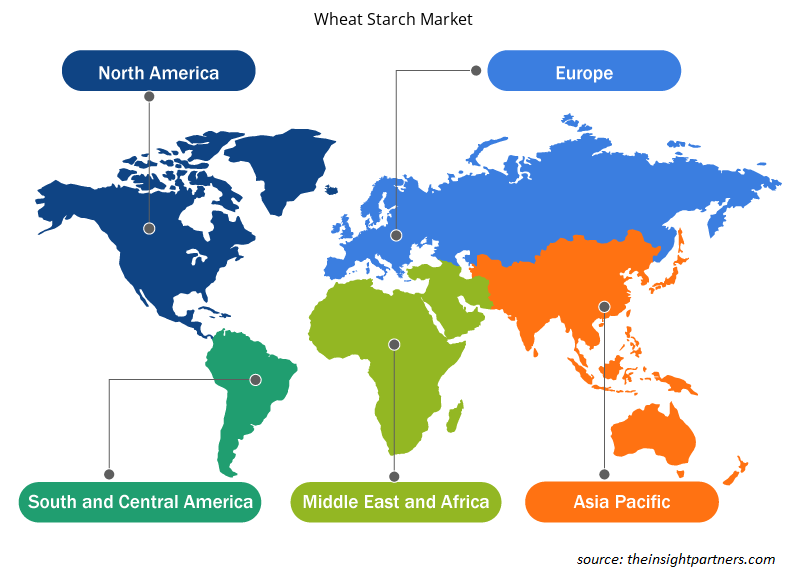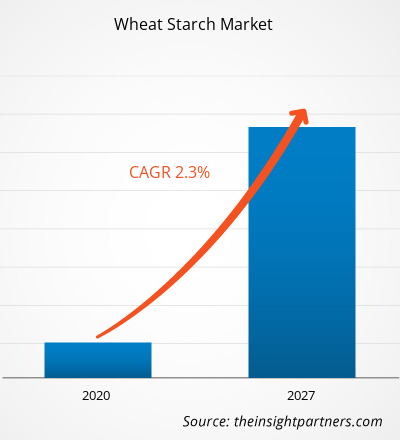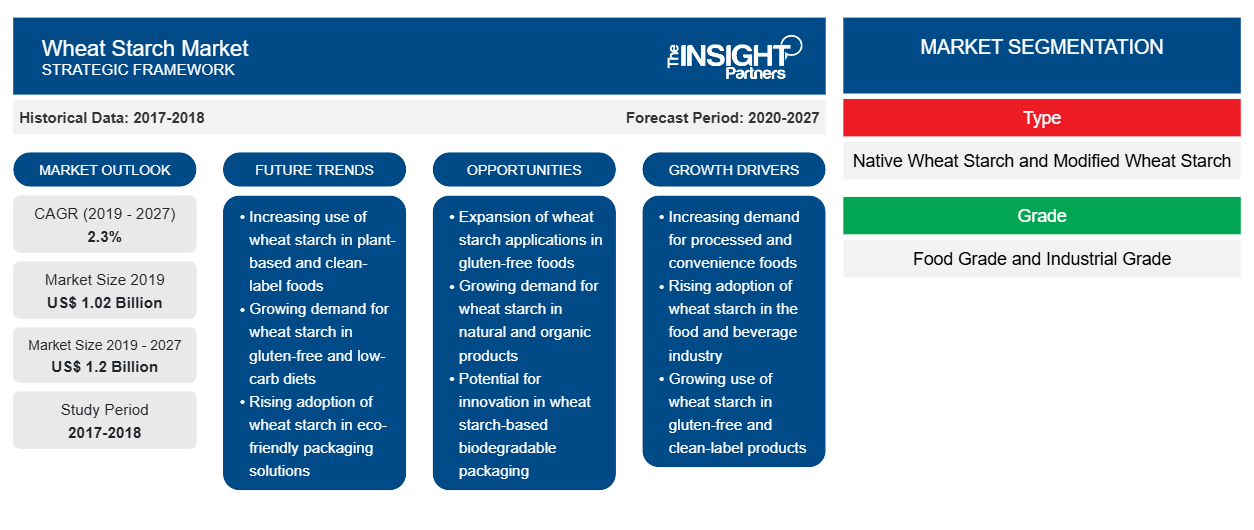2019 年小麦淀粉市场价值为 10.1695 亿美元,预计到 2027 年将达到 12.0332 亿美元;预计预测期内复合年增长率为 2.3%。
小麦淀粉具有优异的胶凝、稳定和增稠特性。当用于食品时,小麦淀粉有助于赋予食品所需的质地和粘度,同时实现凝胶配方、粘合和保湿。它主要用作食品工业中的增稠剂。小麦淀粉通过回生和糊化使食品变稠。热量使淀粉吸收水分并膨胀,同时增加透明度和粘度。然而,一旦达到最大粘度水平,分子就会分开,导致粘度降低。此外,当产品再次开始冷却时,粘度会增加,从而使溶液变浑浊,从而导致凝胶的形成。这是食品和饮料制造商更喜欢在食品中使用小麦淀粉的原因之一。如今,热淀粉在烘焙中的使用也越来越多。改性小麦淀粉赋予某些食品优异的乳化性能。它还可用于土耳其软糖等糖果。它还能有效改善啤酒的泡沫保持力。它也用于制作香肠和肉卷。小麦淀粉是面食的主要成分,约占面食重量的 70%。与其他淀粉类型相比,小麦淀粉可以增加蛋糕的体积和柔软度,还有助于甜甜圈中的脂肪吸收。小麦淀粉通常用于甜味剂,如葡萄糖浆、麦芽糊精和葡萄糖。它被用作酱汁和布丁的稳定剂。
预计在预测期内,亚太地区将占据全球小麦淀粉市场的很大份额。多家国内外公司在该地区站稳了脚跟。亚太地区中产阶级人口的增加和城市化进程的增长为小麦淀粉市场的主要参与者提供了许多机会。原材料(小麦)的易得性有助于促进亚太地区的市场增长。中国在 2019 年占据了亚太地区小麦淀粉市场的主导地位,预计在预测期内仍将引领市场。中国占据主导地位主要归因于企业在开发创新小麦淀粉产品方面的支出不断增加,以及该国拥有成熟的食品和饮料行业
2019 年 12 月,COVID-19 疫情首次在中国武汉爆发,此后,疫情在全球迅速蔓延。截至 2020 年 12 月,美国、印度、巴西、俄罗斯、法国、英国、土耳其、意大利、西班牙、德国、阿根廷、哥伦比亚和墨西哥是受此次疫情影响最严重的国家。根据世界卫生组织的数据,截至 12 月,全球 COVID-19 确诊病例约为 80,773,033 例,死亡病例为 1,783,619 例。由于封锁、旅行禁令和企业停业,COVID-19 已影响到各国的经济和行业。食品和饮料是世界主要行业之一,遭受了供应链中断、技术活动取消和办公室关闭等严重破坏。中国是全球制造业中心,也是各行业最大的原材料供应国。中国各工厂的封锁正在影响全球供应链,并对制造、交货计划和材料销售产生负面影响。各家公司已经宣布产品交付可能延迟,未来产品销售下滑。此外,欧洲、亚洲和北美国家实施的全球旅行禁令也影响了商业合作和伙伴关系机会。
定制此报告以满足您的需求
您可以免费定制任何报告,包括本报告的部分内容、国家级分析、Excel 数据包,以及为初创企业和大学提供优惠和折扣
-
获取此报告的关键市场趋势。这个免费样品将包括数据分析,从市场趋势到估计和预测。
市场洞察
小麦淀粉在药物配方中的潜在应用推动市场增长
世界各地的研究人员和药剂师都在努力探索改性淀粉在药物配方中的潜力,以利用这种淀粉改进的功能和适用性。研究集中于药物辅料的基本要求和淀粉改性方法,如化学、生物技术和物理方法。来自小麦、玉米、大米等的淀粉无色、无味,不溶于酒精和水。在药品生产中,淀粉是一种用途广泛且价格低廉的重要赋形剂。天然小麦淀粉作为固体剂型的粘合剂和崩解剂得到了充分的探索。淀粉正在被改性以增强其物理化学性质,如质地、稳定性和粘度,使其在药物应用中具有良好的流动性和可压缩性。因此,改性淀粉现在被制药行业优先用作可直接压缩的赋形剂,这推动了小麦淀粉市场的增长。
类型洞察
根据类型,小麦淀粉市场分为天然小麦淀粉和改性小麦淀粉。2019 年,天然小麦淀粉占据了市场主导地位。小麦淀粉的物理提取分离了麸质和其他蛋白质。天然小麦淀粉也是小麦食品中使用的植物成分。它是一种白色至灰白色粉末,具有中性气味和味道。它的能量值为 4 kcal/g,即与所有其他碳水化合物相似。天然小麦淀粉用作增稠剂、稳定剂、混浊剂和上光剂;此外,它还可用于粘合和保湿。它用于糖果、烘焙产品、零食、乳制品(如奶酪)、酒精饮料、酱汁和汤、意大利面、即食食品以及肉类和海鲜(如鱼糜)。
成绩洞察
根据等级,小麦淀粉市场分为食品级和工业级。2019 年,食品级市场占据了主导地位。小麦淀粉通常用作食品和饮料行业的膳食补充剂;它也可以用作脂肪替代品。它通过糊化和回缩过程充当食品中的增稠剂。食品级小麦淀粉用于增稠或强化布丁、汤、酱汁和馅饼馅等产品。它有助于质地、粘度、凝胶形成、粘附、粘合和保湿。这种淀粉也是高品质餐厅、酒店和家庭烹饪应用中必不可少的材料。
最终用途行业洞察
根据最终用途行业,小麦淀粉市场细分为食品和饮料、化妆品和其他。2019 年,食品和饮料部门占据了市场主导地位。在食品工业中,小麦淀粉用作增稠剂。此外,由于它能够防止面团弹性,因此在食品和饮料领域最广泛用作增稠剂、食品添加剂和活性成分。此外,它有助于食品粘合过程,也用于制备无麸质和低热量的食品。在许多食品应用中,它也通常用作乳化剂、稳定剂、脂肪替代品和混浊剂或上光剂。它也用于中国饺子皮的面团配方中,因为它有助于使饺子皮具有半透明的稠度。消费者消费无麸质食品的趋势将继续有利于食品和饮料行业使用小麦淀粉。
全球小麦淀粉市场的主要参与者包括嘉吉公司、罗盖特公司、马尼德拉集团、MGP 原料公司、阿彻丹尼尔斯米德兰公司、阿格拉纳集团、Tereos SA、Crespel and Deiters、新西兰淀粉公司和 SacchettoS.pA。这些公司正在实施新产品开发和并购战略,以扩大客户群并在全球范围内获得显著的市场份额,从而使他们能够在全球范围内维护自己的品牌名称。
小麦淀粉市场区域洞察
Insight Partners 的分析师已详细解释了预测期内影响小麦淀粉市场的区域趋势和因素。本节还讨论了北美、欧洲、亚太地区、中东和非洲以及南美和中美洲的小麦淀粉市场细分和地理分布。

- 获取小麦淀粉市场的区域具体数据
小麦淀粉市场报告范围
| 报告属性 | 细节 |
|---|---|
| 2019 年市场规模 | 10.2亿美元 |
| 2027 年市场规模 | 12亿美元 |
| 全球复合年增长率(2019 - 2027) | 2.3% |
| 史料 | 2017-2018 |
| 预测期 | 2020-2027 |
| 涵盖的领域 |
按类型
|
| 覆盖地区和国家 |
北美
|
| 市场领导者和主要公司简介 |
|
小麦淀粉市场参与者密度:了解其对业务动态的影响
小麦淀粉市场正在快速增长,这得益于终端用户需求的不断增长,而这些需求又源于消费者偏好的不断变化、技术进步以及对产品优势的认识不断提高等因素。随着需求的增加,企业正在扩大其产品范围,进行创新以满足消费者的需求,并利用新兴趋势,从而进一步推动市场增长。
市场参与者密度是指在特定市场或行业内运营的企业或公司的分布情况。它表明在给定市场空间中,相对于其规模或总市场价值,有多少竞争对手(市场参与者)存在。
在小麦淀粉市场运营的主要公司有:
- 嘉吉公司
- 罗盖特兄弟公司
- 马尼尔德拉集团
- MGP 成分
- 阿彻丹尼尔斯米德兰公司
免责声明:上面列出的公司没有按照任何特定顺序排列。

- 获取小麦淀粉市场顶级关键参与者概述
报告亮点
- 全球小麦淀粉市场的进步行业趋势有助于参与者制定有效的长期战略
- 发达市场和发展中市场公司采用的业务增长战略
- 2017 年至 2027 年小麦淀粉市场定量分析
- 各行业小麦淀粉需求量估算
- PEST 分析可说明行业内买家和供应商的效率
- 了解竞争激烈的市场形势和小麦淀粉需求的最新发展
- 市场趋势和前景,以及推动和抑制市场增长的因素
- 了解与市场增长相关的商业利益战略
- 小麦淀粉市场各节点规模
- 市场的详细概述和细分以及行业动态
- 全球小麦淀粉市场规模在各个地区以及各个地区都有良好的增长机会
小麦淀粉市场(按类型)
- 天然小麦淀粉
- 改性小麦淀粉
小麦淀粉市场,按等级
- 食品级
- 工业级
小麦淀粉市场,按最终用途行业划分
- 食品和饮料
- 化妆品
- 其他的
公司简介
- 嘉吉公司
- 罗盖特兄弟公司
- 马尼尔德拉集团
- MGP 成分
- 阿彻丹尼尔斯米德兰公司
- 阿格拉纳集团
- 特里奥斯公司
- 克雷斯佩尔和迪特斯
- 新西兰淀粉公司
- 萨凯托公司
- 历史分析(2 年)、基准年、预测(7 年)及复合年增长率
- PEST和SWOT分析
- 市场规模、价值/数量 - 全球、区域、国家
- 行业和竞争格局
- Excel 数据集
近期报告
客户评价
购买理由
- 明智的决策
- 了解市场动态
- 竞争分析
- 客户洞察
- 市场预测
- 风险规避
- 战略规划
- 投资论证
- 识别新兴市场
- 优化营销策略
- 提升运营效率
- 顺应监管趋势























 获取免费样品 - 小麦淀粉市场
获取免费样品 - 小麦淀粉市场